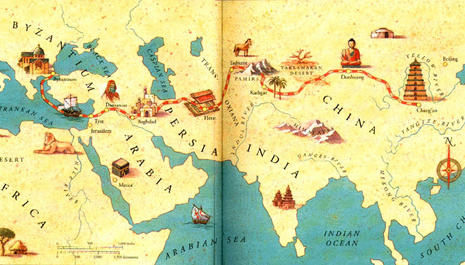Braiding the strands of cultures: W&M launches new program
Two areas of study are being braided together at the College of William & Mary to create a unique academic program that encompasses the languages and cultures practiced by more than half the world’s population.
It’s called the Asian and Middle Eastern Studies Program – a multidisciplinary degree-seeking program that integrates two existing majors – East Asian Studies and Middle Eastern Studies – to engage a changing, globally connected world.
“These regions, which we tend to study in isolation, have historically been connected through trade, travel, pilgrimage, proselytizing, warfare, colonization and similar types of interregional exchanges,” said Professor Sibel Zandi-Sayek, co-director of the Asian Studies Initiative, who teaches courses in art and art history. “They also share comparable, albeit distinct, experiences in their imperial and colonial pasts, nation-building efforts, and modernization processes.”
Three years ago, Asian Studies faculty were awarded a grant from the Freeman Foundation to re-examine how they were teaching Asian studies on the William & Mary campus. More than 35 faculty members throughout the disciplines, covering 11 departments and programs, collaborated to explore the idea of an inclusive program representing Asia in the international world.
After a number of meetings involving students, and brainstorming sessions to sort through key components of the program, the path to moving forward became clear: together.
“Even though we’ve been teaching what have been considered very separate areas, we realized there are lots of bridges between East Asia, the Middle East and South Asia,” said Professor Rachel DiNitto, co-director of the Asian Studies Initiative, who teaches Japanese language, literature, film and culture courses.
Those academic divides have now been bridged through a new, invigorated curriculum. Students can choose a track in East Asia or the Middle East, and will study the history, politics, religion, literature, fine and media arts, performative arts, expressive and ritual culture, and the major languages of the region. Minors can also be picked up in one of four core areas: East Asian Studies or Middle Eastern Studies, or from two newly created minors in South Asian Studies or Comparative and Diaspora Studies.
“We wanted to offer students a broad, interdisciplinary scope, but also a more in-depth specialization,” said DiNitto. Having a sense of specialization in more than one area is vital, she said, especially for students wanting to pursue jobs in Foreign Service and government work.
Dean of Arts & Sciences Carl Strikwerda said the merging of East Asian Studies and Middle Eastern Studies “allows faculty in these two world areas to integrate their teaching, research and outreach to the campus more effectively.” The merger also gives faculty a chance to explore topics like, Islam, Buddhism and Indian Ocean cultures in exciting new ways, he said.
The program is scheduled to launch fall 2011. Current students who are freshman or sophomore status, along with incoming freshman students, are eligible for the program.
“It’s a huge advantage for students, especially because of the interconnectedness of the world at this point in time,” said DiNitto, adding, “they will learn how bigger issues reverberate throughout the world and other cultures."















